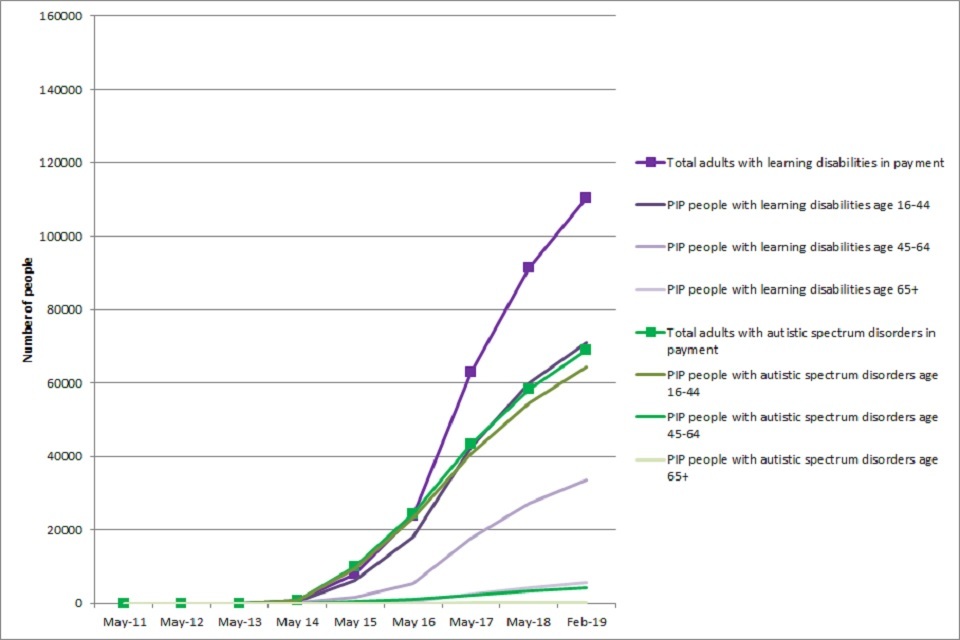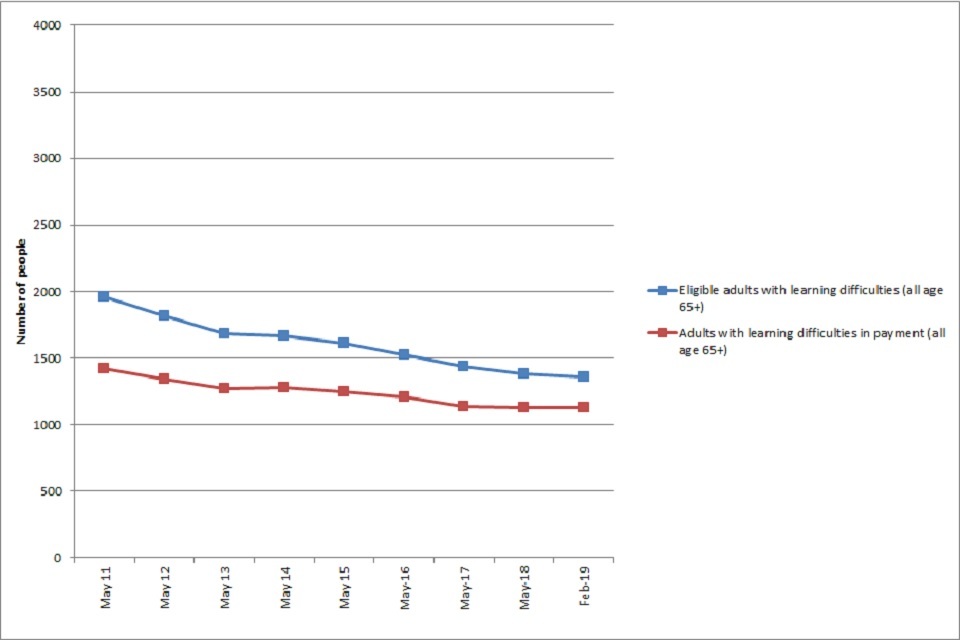Chapter 4: disability benefits
Updated 27 January 2020
Summary
The Department for Work and Pensions (DWP) reports monthly or quarterly information on disability benefits for people labelled as having ‘learning difficulties’ or ‘learning disabilities’.
Disability Living Allowance (DLA)
In February 2019, a total of 296,885 people in the category of ‘learning difficulties’ (99% of those eligible for DLA) were getting DLA payments at an average £83.67 per person per week. This number increased up to 2015, and has been decreasing since. In February 2019, the majority of people with learning difficulties receiving DLA payments (70%) were children and young people aged under 18 years old.
Personal Independence Payment (PIP)
In February 2019, a total of 110,437 adults aged 16 years or over, in the category of ‘learning disabilities’ were receiving PIP payments, a rapid increase from the introduction of PIP in 2014. Since the introduction of PIP, 8% of PIP applications related to people with learning disabilities ‘cleared’ by the DWP - PIP process have been disallowed.
In February 2019, a total of 68,847 adults aged 16 years or over, in the category of ‘autistic spectrum disorders’ were receiving PIP payments, a rapid increase from the introduction of PIP in 2014. Since the introduction of PIP, 32.6% of PIP applications related to autistic people ‘cleared’ by the DWP PIP process have been disallowed.
Attendance Allowance (AA)
In February 2019, a total of 1,127 adults aged 65 years or over, in the category of ‘learning difficulties’ (83% of those eligible for AA) received AA payments at an average £66.04 per person per week. The number of people with learning difficulties receiving AA has gradually reduced over time.
People with learning disabilities in England
National statistical information on the characteristics of people with learning disabilities, and the services and supports they and their families use, is collected by several government departments. The aim of People with Learning Disabilities in England, produced by the Learning Disabilities Team at Public Health England (PHE), is to provide a concise summary of this information.
Previous versions have been produced as a single report, most recently People with Learning Disabilities in England 2015[footnote 1]. In this version, individual sections are updated as data become available, to allow for more regular and timely updates of national statistics.
Benefits
People with learning disabilities in England, as with other groups of people, are potentially eligible for a range of benefits. Statistics for the major benefit types are available monthly or quarterly from the Department for Work and Pensions (DWP)[footnote 2].
Data on Housing Benefit, Income Support, Jobseekers Allowance, Pension Credit and Universal Credit are not disaggregated using disability categories.
Data for Employment and Support Allowance, the Work Programme, and Incapacity Benefit and Severe Disablement Allowance can be disaggregated by ICD-10 chapter codes[footnote 3] for different health needs categories, but these are too broad to allow the identification of people with learning disabilities.
DWP data can be disaggregated using the category of ‘learning difficulties’ for Disability Living Allowance (DLA) and Attendance Allowance (AA), and the category of ‘learning disabilities’ for the Personal Independence Payment (PIP).
Disability Living Allowance
The Department for Work and Pensions (DWP) provides quarterly information on Disability Living Allowance (DLA), that can be disaggregated for adults with ‘learning difficulties’ in England.
The DWP definition of ‘learning difficulties’ includes:
- ‘learning difficulties’’ (an old generic code still used for pre-2008 cases before more detailed sub-categories were introduced)
- ‘Down’s syndrome’
- ‘Fragile X syndrome’
- ‘learning disability - other/type not known’
- ‘Autism’
- ‘Asperger syndrome’
- ‘Retts disorder’[footnote 4]
This definition is broader than other government departments’ definitions of the population of people with learning disabilities.
The Disability Living Allowance (DLA) is a tax-free benefit for disabled people who need help with mobility or care costs. Disability Living Allowance (except for those born before 9 April 1948 and those aged under 16 at the time of application) is being replaced by Personal Independence Payments. The DLA consists of 2 components which are assessed and paid separately, a Care Award (paid at higher, middle and lower rates) and a Mobility Award (paid at higher and lower rates).
Figure 1 below (see also Tables 1 and 2 in the accompanying data tables document for more details) shows the number of people with ‘learning difficulties’ eligible for and receiving DLA from May 2011 (the first year that figures based on a total sample were available) to February 2019.
In Figure 1 the number of people with ‘learning difficulties’ receiving DLA are also broken down into 4 age bands:
- age 0 to 17 years
- age 18 to 44
- age 45 to 64
- age 65 or over

Figure 1: Disability Living Allowance (DLA), showing the number of people with learning difficulties eligible for and receiving DLA increasing from 2011 to 2015 and decreasing after 2015
As Figure 1 shows, in February 2019, a total of 296,885 people in the category of ‘learning difficulties’ were getting DLA payments, 99% of those eligible. This total number increased up to 2015, and has been decreasing since.
Examination of age bands of people receiving DLA shows that the number of children and young people receiving DLA has continued to increase up to 2019, whilst the number of working age adults receiving DLA has decreased substantially from 2015 to 2019. By February 2019, the majority of people with ‘learning difficulties’ receiving DLA payments (70%) were children and young people aged under 18 years old. In interpreting these figures consider the introduction of Personal Independence Payments (PIP).
In February 2019, people with ‘learning difficulties’ were receiving DLA at an average £83.67 per person per week - resulting in an estimated annual cost of Disability Living Allowance payments to people with ‘learning difficulties’ of approximately £1.3 billion.
Personal Independence Payments
Information on the number of people claiming Personal Independence Payments (PIP: a benefit for adults with sickness and or disability replacing the DLA, but with some important differences) is available on a monthly basis for adults with learning disabilities, under the category ‘Main Disabling Condition/Psychiatric Disorders/Learning Disability Global’, and for autistic people under the label ‘Main Disabling Condition or Psychiatric Disorders or Autistic Spectrum Disorders’ .
Figure 2 below (see also Tables 1 and 2 in the accompanying PDF data tables document for more details) shows the number of people with ‘learning disabilities’ and the number of people with ‘autistic spectrum disorders’ receiving PIP from May 2014 to February 2019. In Figure 2 the number of people receiving PIP are also broken down into 3 age bands: age 16 to 44; age 45 to 64; and age 65 or over.
As Figure 2 shows, in February 2019, a total of 110,437 adults aged 16 years or over in the category of ‘learning disabilities’ were receiving PIP payments, a rapid increase from the introduction of PIP in 2014. These increases were larger amongst younger adult age groups. In February 2019, a total of 68,847 adults aged 16 years or over in the category of ‘autistic spectrum disorders’ were receiving PIP payments, with almost all of these people being in the younger working age adult age band.
Since the introduction of PIP, 8.1% of PIP applications related to people with learning disabilities and 32.6% of PIP applications related to autistic people that have been ‘cleared’ by the DWP PIP process have been disallowed post-referral due to ‘failing’ the assessment.

Figure 2: Personal Independence Payment (PIP), showing the number of people with learning disabilities and the number of adults with autistic spectrum disorders receiving PIP increasing rapidly after its introduction in 2014
Attendance Allowance
Attendance Allowance (AA) is paid to disabled people over the age of 65 to help with personal care. They can be paid at 2 rates to reflect the level of care required.
Figure 3 below (see also Tables 1 and 2 in the accompanying data tables PDF document) shows the number of people with ‘learning difficulties’ who are eligible for and receiving Attendance Allowance in England, from the quarter ending May 2011 to the quarter ending February 2019. Eligibility statistics include those who have had their payment temporarily suspended, for example if they are in hospital.

Figure 3: Attendance Allowance (AA), showing the relatively small number of older adults with learning difficulties eligible for and receiving AA gradually decreasing from 2011 to 2019
As Figure 3 shows, from 2011 to 2019 the number of people with ‘learning difficulties’ who are eligible for or claiming Attendance Allowance has steadily declined. This may be because people eligible for DLA or PIP before the age of 65 years remain with these benefits into older age rather than transferring to Attendance Allowance (which is only awarded to people with newly identified needs at age 65 or more). In February 2019, 83% of people with ‘learning difficulties’ who are eligible for Attendance Allowance were receiving it.
In the quarter ending February 2019, 1,127 people with ‘learning difficulties’ over 65 received Attendance Allowance at an average rate of £66.04 per person per week. Using these figures indicates that the estimated annual cost of Attendance Allowance payments to people with ‘learning difficulties’ for 2018 to 2019 was approximately £3.9 million.
References
-
Public Health England People with Learning Disabilities in England 2015 London: Public Health England; 2016 ↩
-
Department for Work and Pensions Stat-Xplore ↩
-
World Health Organization The ICD-10 Classification of Mental and Behavioural Disorders: clinical descriptions and diagnostic guidelines Geneva: WHO; 2003. ↩
-
Department for Work and Pensions (2014) Freedom of Information request 2014-568. ↩
